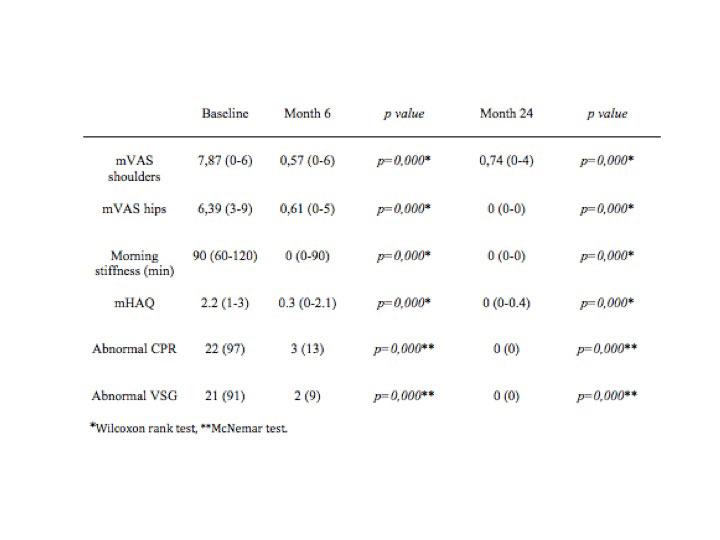Session Information
Session Type: Poster Session (Sunday)
Session Time: 9:00AM-11:00AM
Background/Purpose: Polymyalgia rheumatic (PMR) is a common rheumatic inflammatory disease in the elderly. Glucocorticoids (GC) are the therapeutic mainstay in PMR but induce significant toxicity in this population. Methotrexate (MTX) has demonstrated efficacy as a steroid sparing agent in two randomized clinical trials but has not been studied as first line therapy. Our objetive is to evaluate the efficacy and safety of first-line MTX plus initial and on demand local GC infiltrations without oral GC.
Methods: In a single-center prospective observational study, 26 patients with newly diagnosed PMR (EULAR/ACR criteria) who had not received oral GC, were treated with MTX plus initial and on demand shoulder infiltrations with 40 mg triamcinolone acetonide for 24 months. At each visit (at one month and on a quarterly basis) patient 100 mm VAS pain for shoulders and hips, morning stiffness duration and HAQ were recorded. Remission was defined as absence of reported pain and morning stiffness and normalization of acute phase reactants (APR). After two years of treatment, MTX was withdrawn and patients were followed-up for additional 14±4 months. The primary end point was the rate of PMR remission at 6 months. Secondary outcomes were toxicity, remission at 24 months and relapses after MTX withdrawal.
Results: 26 patients were included. Three patients did not complete the study due to prostate cancer, an asthmatic episode requiring high dose GC, or MTX intolerance. These 23 patients (57% female) had a mean age of 74±8 years and a mean disease duration of 110±55 days. Initial weekly MTX dose was 5 mg in 14 patients and 7,5 mg in 9, and further increased according to efficacy/toxicity. Only 5 patients required more than 10 mg and the mean dose was 9±3 mg. Mean time until remission was 2.7±1.9 months. Other measures of efficacy are shown in Table 1. The mean number of GC infiltrations along the 24 months was 1.4±0.7 per shoulder. During the first 24 months, 5 patients had relapses that resolved with MTX dose increase and/or GC shoulder infiltration. MTX was well tolerated in all but one patient initially excluded due to digestive intolerance. Side effects included one alopecia, one mild thrombopenia, one diabetes onset, and one respiratory infection, but none required MTX suspension. None suffered osteoporotic fractures. In 20 of the 23 patients, MTX was stopped after 24 months, and after 14±4 months of follow-up no relapses were observed.
Conclusion: Low dose methotrexate is effective as initial therapy for PMR in combination with a very limited exposure to local GC infiltrations. Randomized controlled trials are warranted to confirm this observation that may significantly reduce GC side effects in this population
To cite this abstract in AMA style:
Retuerto M, Fernández-Dapica P, Lavilla P, Lozano F, Vallejo M, Pablos J. Polymyalgia Rheumatica: New Therapeutic Strategy Based on Low Dose Metrotexate Plus Local Infiltration with Corticosteroids [abstract]. Arthritis Rheumatol. 2019; 71 (suppl 10). https://acrabstracts.org/abstract/polymyalgia-rheumatica-new-therapeutic-strategy-based-on-low-dose-metrotexate-plus-local-infiltration-with-corticosteroids/. Accessed .« Back to 2019 ACR/ARP Annual Meeting
ACR Meeting Abstracts - https://acrabstracts.org/abstract/polymyalgia-rheumatica-new-therapeutic-strategy-based-on-low-dose-metrotexate-plus-local-infiltration-with-corticosteroids/

